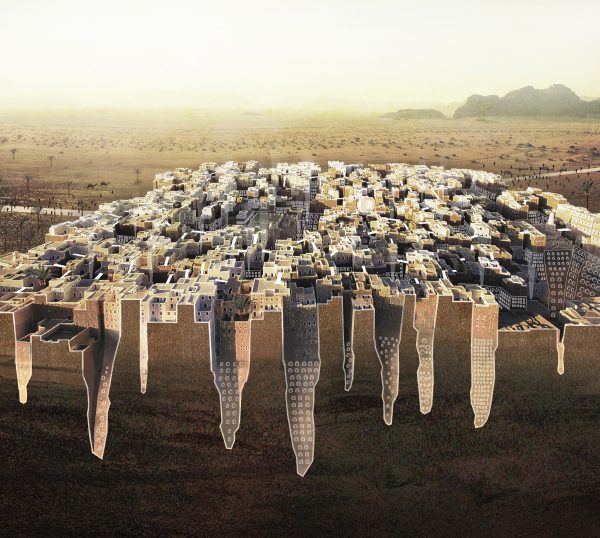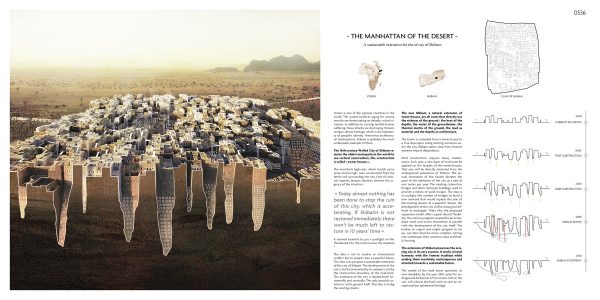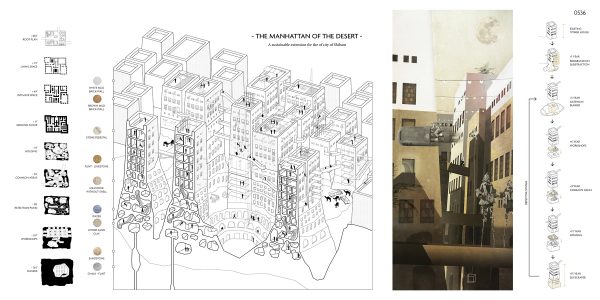Honorable Mention
2018 Skyscraper Competition
Estelle Filliat, Charlotte Ferreux, Duc Truong, Elias Vogel
France

Yemen is one of the poorest countries in the world. The armed conflicts raging for several months are deteriorating an already critical situation. In addition to causing terrible human suffering, these attacks are destroying Yemen’s unique cultural heritage, which is the repository of people’s identity. Yemen has architectural masterpieces. Shibam is probably the most emblematic example of them. The 16th-century Walled City of Shibam remains the oldest metropolis in the world to use vertical construction, this construction is called « tower houses». The mud-brick high-rises, which stretch up to seven stories high, were constructed from the fertile soil surrounding the city. One of Unesco’s experts, Jacques Heyman, stresses the urgency of the situation : «Today almost nothing has been done to stop the ruin of this city, which is accelerating. If Shibalm is not restored immediately there won’t be much left to restore in 10 years’ time ». It seemed essential to put a spotlight on this threatened city. We must reverse the situation !
The idea is not to resolve an international conflict but to project into a peaceful future. The idea is to propose a sustainable extension of the city of Shibam. The development of the city is both constrained by its ramparts and by the constructive boundary of the mud-brick. The extension of the city is limited both horizontally and vertically. The only possible solution is in the ground itself. The idea is to dig the existing streets. The new Shibam, a natural extension of tower houses, are all roots that directly use the richness of the ground : the heat of the depths, the water of the groundwater, the thermal inertia of the ground, the mud as material and the depths as architecture. The tower is extended from a tower-house to a true skyscraper. Using existing resources under the city, Shibam steers clear from Yemen’s extreme import dependence.
Mud construction requires heavy maintenance. Each year, a new layer of mud must be applied on the facades of the tower-houses. That one will be directly extracted from the underground extensions of Shibam. The annual renovation of the facade dictates the pace of the extension of the city at a rate of one meter per year. The existing connective bridges and doors between buildings used to provide a means of quick escape. The idea is to multiply the number of bridges to build a new network that would replace the one of the existing streets. In a peaceful Yemen, the development of the city will be strong but difficult to anticipate. That’s why the proposed expansion model offers a great deal of flexibility.
The various programs respond to an immediate need, and enrich themselves in parallel with the development of the city itself. The bunker, an urgent and simple program to set up, can then become more complex, turning into workshops, then common areas and finally housing.
The extension of Shibam preserves the existing city in its very essence. It works in total harmony with the Yemeni tradition while making them resolutely contemporary and oriented towards a sustainable future. The model of the mud tower questions its own durability. By the year 2100, only the under ground footprints of the towers left on the soil, will witness the hard work to save an exceptional but ephemeral heritage.


This work is licensed under a Creative Commons License permitting non-commercial sharing with attribution. https://creativecommons.org/licenses/by-nc-nd/4.0/



